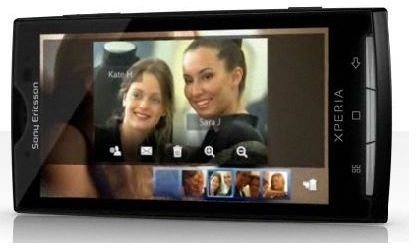Review of Sony Ericsson Xperia X10: Part 1
Introduction

Sony Ericsson’s Xperia X10 is their first Android device. While this usually presents an excuse for the manufacturer to forgive any and all shortcomings in the device, in the case of the X10, it holds no water. This is a big release for Sony Ericsson and they’ve gone for a big screen and plenty of features.
The X10 is designed to bring together all the joys of a smartphone, a touch screen, staggering customization because of Android and many other great features. It is by no means an inexpensive phone, and will set back anybody a considerable amount.
Design (5 out of 5)
The first impression of the phone is its sheer size, although, with a 4-inch screen, it is hardly surprising. The surprising part is that the X10 feels much lighter than expected. The casing is completely plastic, which contributes significantly to its distinct lack of heft at 135 grams.
The phone is very sleek, despite its large size. The edges are slim and rounded, fitting nicely into a user’s palm. The edges are kept simple and uncluttered, with delicate chrome detailing for an elegant finish.
The front is dominated by the 4-inch screen, leaving little room for anything else. The screen has an impressive resolution of 854 x 480 pixels, and excellent picture quality.
It is available in two colours, white and black. The black version definitely has a more elegant appeal, while the white is more drastic.
User Interface (4 out of 5)
Since the phone has Android as an operating system, customization is a big factor. Android home screens are flexible and intuitive, making the user experience really good. Both Timescape and Mediascape have been added to the phone.
Timescape is essentially a timeline of all communications, displayed in a virtual stack. The stack can be customized to show the communications with one particular contact, or with all the contacts in general.
The home screen is entirely free of clutter initially, leaving it entirely up to the user to add widgets as they see fit. The main menu is at the bottom, and is brought up, simply by dragging the finger upwards. A similar concept has been used at the top of the phone as well, with a slide-down menu for notifications. The interesting part of the notifications area is that it is usually a bar, with the common notification signs. However, on sliding the panel down, all the events are shown in greater detail. This way, the user is not interrupted when using the phone during other activities.
The user interface can have as many or as few shortcuts as the user chooses, which makes an individual’s experience tailored to their needs.
Features (5 out of 5)

The phone also has an 8 megapixel camera with an unfortunate LED flash. There are the usual suspects in camera modes and settings. A handy addition is the recently-taken strip at the bottom of the screen. Another interesting addition, apart from touch focus is the face recognition. It seems that Sony is finally bringing the Cybershot glory to their mobile phones.
Mediascape, as mentioned before, is a great gallery application, as it brings together all the multimedia content on the phone in one easy-to-browse place. It also has a unique button at the base of the phone which allows the user to connect to related Internet services – which is a great instance of integration.
The contact manager has been revamped, taking Android into consideration. One of the great features of Google products is the integration, and this integration is visible in the X10, with Gmail links. In fact, Gmail is not the only service that can be linked, as the new phonebook has the ability to link Facebook and Twitter accounts as well. New contacts are created with the bare minimum of fields, instead of the never-ending list; there is always the option to add additional information as and when required.
Messaging is again reminiscent of Google, with the lack of folders. All the messages are stored as threads, which makes viewing conversations significantly easier. Text input options are good, with both landscape and portrait QWERTY keyboards. There are other keyboards that can be downloaded too, depending on preferred language.
The web browser on Android phones is always great, and with tab support, there is no complaint. As usual there is no Flash support; however that was expected.
Connectivity is standard, with Bluetooth and all the other high-speed Internet options as well. Sony Ericsson phones were notorious for proprietary ports for computer connectivity, but thankfully they’ve decided to add a microUSB port instead. There is a bundled GPS system as well, although the version supplied is not free. However, with Google Maps, there is no real worry in this department.
Performance (4 out of 5)
Call quality is excellent, as to be expected with Sony phones. There is no voice dialling, which is really an Android issue. However, it is not absolutely essential, although the feature would have been nice.
Although the phone is remarkably fast when moving from one screen to the next, there is a noticeable lag when it comes to the media browser. However, it is a minor hitch as the zoom function works smoothly in Mediascape. It has a powerful 1 GHz processor, so the phone runs very nicely.
The battery is adequate, although communicative individuals may find that the phone gives up halfway through the day. With features like a 4-inch touchscreen, it is hardly surprising.
The Verdict (5 out of 5)
The Sony Ericsson Xperia X10 is a marvellous device, with sleek good looks and substantial features. It has smartphone features, although the multimedia angle is what makes the phone truly appealing. It may be slightly on the large side, but the 4-inch touchscreen more than makes up for the inconvenience.
The phone will certainly make a large dent in anyone’s budget. It may be a good idea to wait for the next model to release if Sony doesn’t come through with an Android update.